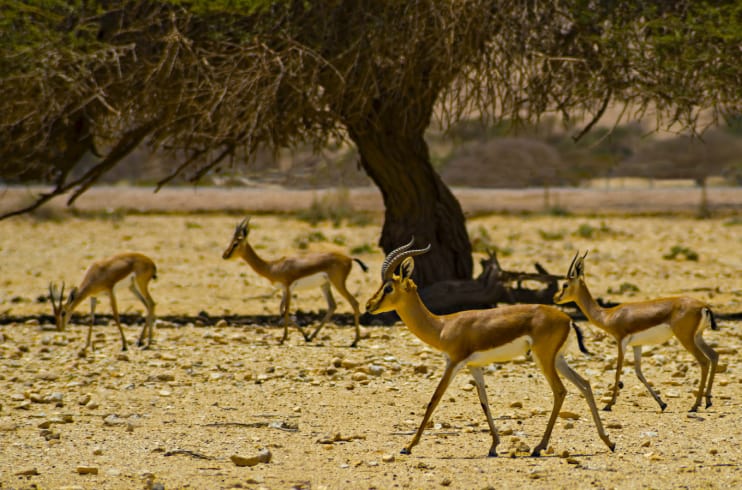The Dorcas Gazelle is a gazelle native to the deserts of the Middle East, including Israel. They are known for their slender, elegant bodies and distinctive horns, which are longer in males and curve upwards.

Credit: MinoZig, CC BY-SA 4.0, via Wikimedia Commons
The Dorcas Gazelle (Also known as Negev Deer) live in herds. The Dorcas Gazelle used to be found in various areas: in the south of Israel (the Judean desert, the Arava valley, and the southern Negev), in the Sinai, in Jordan, and the deserts of North Africa. One of its distinguishing features is the fact that it can adapt to being in deserts without the need to drink water. This is because he extracts the water he needs from liquids found in the acacia leaves that he usually eats. That’s why it was so common in desert areas.
The Dorcas Gazelle In Israel
The Dorcas Gazelle did not exist in the Land of Israel before the Holocene. The existing population represents remnants of a migration from North Africa that displaced the common deer from parts of the Negev and Sinai, starting about 10,000 years ago. Israel’s Negev Deer population is concentrated in the Arava and Southern Negev regions. In the 60s and 70s of the 20th century, the population of the Negev was almost destroyed due to uncontrolled hunting. Still, since the enforcement of the “Wildlife Protection Law,” the phenomenon has been curbed, and a gradual recovery is evident in the number of individuals observed.

The Symbiotic Relationship with the Acacia Tree
The Dorcas Gazelle has a close symbiotic relationship with the acacia tree. The acacia tree is known for the symbiotic relationships between it and various animals. Such a connection also exists between him and Dorcas Gazelle.
During the summer, the Dorcas Gazelle usually shelters in the shade of the acacia tree during the hot hours, and it feeds mainly on its top and fruits. As mentioned, this food also provides him with the water necessary for his existence. The Dorcas Gazelle eating the fruits of the acacia tree chews only part of the seeds found in the fruit. The unchewed seeds pass through his digestive system unharmed and are expelled with feces.
In this way, the Dorcas Gazelle spreads the acacia seeds. Studies have found that these seeds germinated more successfully than seeds that did not pass through the Negev deer’s digestive system. It turned out that the hard shell of the acacia seeds softens in the Nefev Deer’s digestive system. Softening the shell increases the chance that the seeds will germinate. It was also discovered that the digestive substances in the deer’s stomach kill the larvae of the seed beetles, which develop inside the seeds and damage them.
Visitors to Israel can observe the Dorcas Gazelle in its natural habitat by visiting nature reserves such as the Ramon Nature Reserve and the Eilat Mountains, where they can see these beautiful animals in their native environment and learn more about their habitat and conservation.

